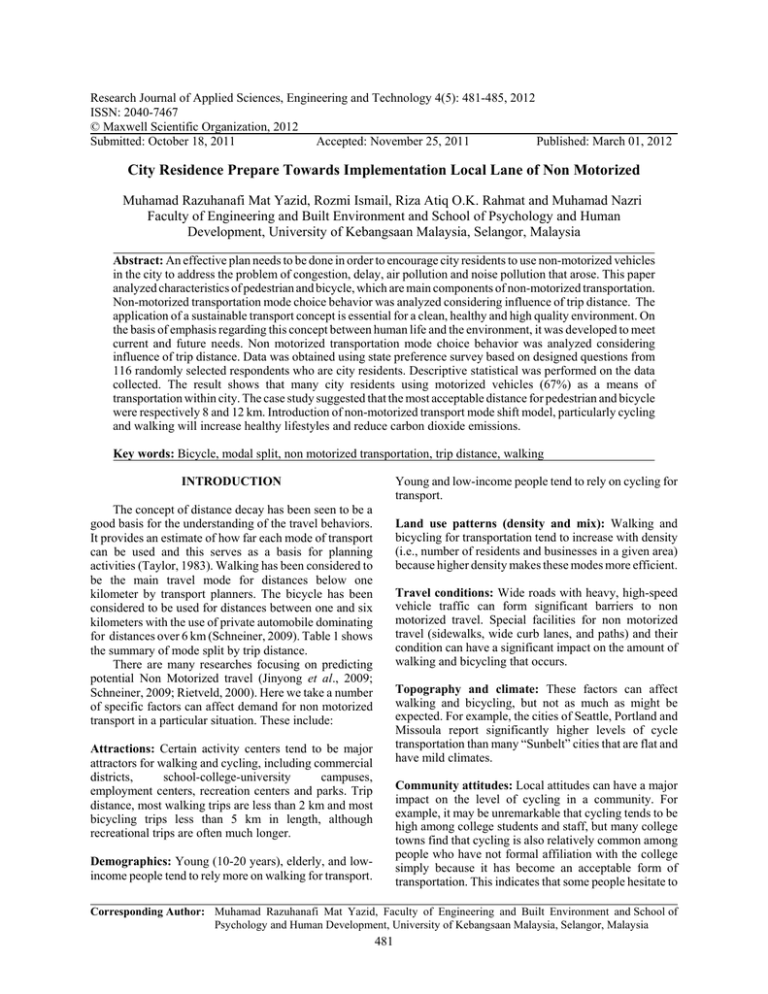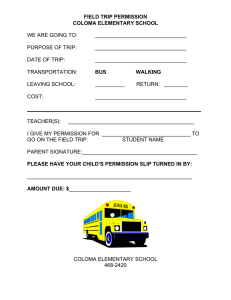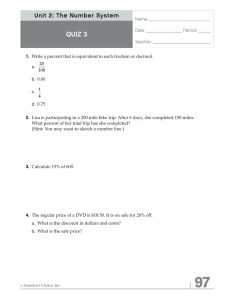Research Journal of Applied Sciences, Engineering and Technology 4(5): 481-485,... ISSN: 2040-7467 © Maxwell Scientific Organization, 2012
advertisement

Research Journal of Applied Sciences, Engineering and Technology 4(5): 481-485, 2012 ISSN: 2040-7467 © Maxwell Scientific Organization, 2012 Submitted: October 18, 2011 Accepted: November 25, 2011 Published: March 01, 2012 City Residence Prepare Towards Implementation Local Lane of Non Motorized Muhamad Razuhanafi Mat Yazid, Rozmi Ismail, Riza Atiq O.K. Rahmat and Muhamad Nazri Faculty of Engineering and Built Environment and School of Psychology and Human Development, University of Kebangsaan Malaysia, Selangor, Malaysia Abstract: An effective plan needs to be done in order to encourage city residents to use non-motorized vehicles in the city to address the problem of congestion, delay, air pollution and noise pollution that arose. This paper analyzed characteristics of pedestrian and bicycle, which are main components of non-motorized transportation. Non-motorized transportation mode choice behavior was analyzed considering influence of trip distance. The application of a sustainable transport concept is essential for a clean, healthy and high quality environment. On the basis of emphasis regarding this concept between human life and the environment, it was developed to meet current and future needs. Non motorized transportation mode choice behavior was analyzed considering influence of trip distance. Data was obtained using state preference survey based on designed questions from 116 randomly selected respondents who are city residents. Descriptive statistical was performed on the data collected. The result shows that many city residents using motorized vehicles (67%) as a means of transportation within city. The case study suggested that the most acceptable distance for pedestrian and bicycle were respectively 8 and 12 km. Introduction of non-motorized transport mode shift model, particularly cycling and walking will increase healthy lifestyles and reduce carbon dioxide emissions. Key words: Bicycle, modal split, non motorized transportation, trip distance, walking Young and low-income people tend to rely on cycling for transport. INTRODUCTION The concept of distance decay has been seen to be a good basis for the understanding of the travel behaviors. It provides an estimate of how far each mode of transport can be used and this serves as a basis for planning activities (Taylor, 1983). Walking has been considered to be the main travel mode for distances below one kilometer by transport planners. The bicycle has been considered to be used for distances between one and six kilometers with the use of private automobile dominating for distances over 6 km (Schneiner, 2009). Table 1 shows the summary of mode split by trip distance. There are many researches focusing on predicting potential Non Motorized travel (Jinyong et al., 2009; Schneiner, 2009; Rietveld, 2000). Here we take a number of specific factors can affect demand for non motorized transport in a particular situation. These include: Land use patterns (density and mix): Walking and bicycling for transportation tend to increase with density (i.e., number of residents and businesses in a given area) because higher density makes these modes more efficient. Travel conditions: Wide roads with heavy, high-speed vehicle traffic can form significant barriers to non motorized travel. Special facilities for non motorized travel (sidewalks, wide curb lanes, and paths) and their condition can have a significant impact on the amount of walking and bicycling that occurs. Topography and climate: These factors can affect walking and bicycling, but not as much as might be expected. For example, the cities of Seattle, Portland and Missoula report significantly higher levels of cycle transportation than many “Sunbelt” cities that are flat and have mild climates. Attractions: Certain activity centers tend to be major attractors for walking and cycling, including commercial districts, school-college-university campuses, employment centers, recreation centers and parks. Trip distance, most walking trips are less than 2 km and most bicycling trips less than 5 km in length, although recreational trips are often much longer. Community attitudes: Local attitudes can have a major impact on the level of cycling in a community. For example, it may be unremarkable that cycling tends to be high among college students and staff, but many college towns find that cycling is also relatively common among people who have not formal affiliation with the college simply because it has become an acceptable form of transportation. This indicates that some people hesitate to Demographics: Young (10-20 years), elderly, and lowincome people tend to rely more on walking for transport. Corresponding Author: Muhamad Razuhanafi Mat Yazid, Faculty of Engineering and Built Environment and School of Psychology and Human Development, University of Kebangsaan Malaysia, Selangor, Malaysia 481 Res. J. Appl. Sci. Eng. Technol., 4(5): 481-485, 2012 Table 1: Summary of finding on mode split according to trip distance Study Jinyong et al. (2009) studied statistical analysis on Non-motorized transportation mod choise considering trip distance and car availability Schneiner (2009) studied interrelations between travel mode transportation mode choice considering trip distance and car availability choice and trip distance: trends Rietveld (2000) studied biking and walking: The position of non-motorized transport modes in transport systems the Gatersleben and Appleton (2007) found that Contemplating different stages of change Winters et al. (2010) found that Motivators and deterrents of bicycling: comparing influences on decisions to ride. Nurdden et al. (2007) studied effect of transportation policies on modal shift from private car to public transport in Malaysia. The survey data in Netherlands show that trips up to 1 km are dominated by pedestrians.The cycling distance is respectively about 1 and 3.7 km and the motorized for up to distances of 7.5 km The study presented was particularly interesting as people who lived less than 5 miles (8 km) from work. Model is therefore not applicable for people who lived too far away from work The study presented was more than 80% live within a reasonable cycling bicycling: comparing influences on decisions to ride. distance <8 km of at least one common destination Distance from home to public transport (700 m) and distance from home to work (30 km) are the contributing factors that influence the model shift from car to public transport in Malaysia distance. Data on stated preference survey data collected in Kota Baharu city in Kelantan province in Malaysia, Non motorized transportation mode choice probability is formulated considering trip distance. PT Car Travel mode percentage (%) 100 90 80 70 60 50 40 30 20 10 0 Walking Bicycle Findings NMT prevails in short distance trip for pedestrian and non motorized non motorized transportation should act as an effective transfer to public should act as an effective transportation (railway, bus ) The data show that walking is prevalent in short trip distance less than 1 km, bicycle for distance between 1 and 6 km and the car for MATERIALS AND METHODS 0 1 2 3 4 5 6 7 8 The target respondent of this survey is any individual who uses a motor vehicle to get feedback from them about their readiness to shift to non-motorized vehicles (walking and cycling). Questionnaires were used to collect data in this study. According to Ahern and Tapley (2007) the choice of survey questionnaires (stated preferences) is used for actual users and potential of an attitude or a choice of consumers when they face a choice situation. Respondents are required to make decisions on the options was determined researchers when faced with certain situations. Questionnaires were designed in four parts: 9 Trip distance (km) Fig. 1: Model split by trip distance in 2002 in Germany (Schneiner, 2009) cycle, but will if they perceive it to be more socially acceptable. C C C Time and geographic scope: It may take several years for a community to fully achieve its full non motorized travel potential. First year impacts are frequently modest, but tend to increase as individuals become more accustomed to non motorized travel and as additional support facilities (pedestrian and bicycle network, bicycle parking, etc.) develop (FHWA, 1999). Figure 1 were travel mode split in 2002 in Germany. The data show that pedestrian is prevalent in short trip distance less than 2 km. When trip distance increases to nearly 2 km, bicycle is selected more frequently than pedestrian. Public transportation is less selected. Car use is the most frequent mode, especially when distance increase to 1 km and above, car use exceeds that of pedestrian and become the most favorable travel mode. The objective of this study is to investigate non motorized transportation mode choice behavior considering trip C Part A: Background information on respondents, Part B: Profile of Travel, Part C: a willingness to switch to non-motorized vehicles Part D: to provide facilities for non-motorized vehicles and the proposed policy. The data obtained are analyzed using the Statistical Package for Social Sciences Software (SPSS) version 18 and this data was then put into Microsoft Excel for the curve fitting. A field study was conducted at the Kota Bharu in the Kelantan of the Malaysia. This survey was done on work days (Monday through Thursday). A total of 116 of the respondents in this study have been involved in 2 months (25 July to 23 September, 2011). This amount is obtained from the calculation of the total sample schedule made by the Bartlett et al. (2001) by Cochran (1977) introduced formula in. They were elected 482 Res. J. Appl. Sci. Eng. Technol., 4(5): 481-485, 2012 50 44% 33% 40 24% 35% 30 21% 20 13% 11% 10% 10 9% 0 Pub. Transport Walk Cycle Work Motorcycle Shopping Education Other Fig. 3: Traveled by trip purpose in district of Kota Bharu Fig. 2: Travel mode in district of Kota Baharu was 33% driving, 21% motorcycling, 24% walking, 13% using public transport and 9% of respondents to the cycling to and from Kota Bharu cities center. From the frequency distribution, the majority use of motor vehicles (67%) compared with non-motorized vehicles (33%) to and from Kota Bharu city center. Figure 3 shows the revealed substantial differences by purpose. From Fig. 3, it found that the greatest travelled were for work with 44% and shopping for 35% relatively. Table 2 and 3 shows the household travel survey collected information about how far individuals travel and the mode of transport they used for each trip. The data was grouped based on the distance travelled by individuals in group of one kilometer increase. The number of trips made by each mode of transport within by a simple (convenience) in which they are involved in the requested fill in the questionnaire in person. Before filling in the questionnaire respondents are given a description of research and instruction - instruction in the questionnaire. Procedures for determining sample size for continuous data variable using Cochran’s (1977) formulas. These procedures result in a sample size of 116. RESULTS AND DISCUSSION Result of this study was based on respondents from 116 city residence of Kota Bharu, respondent's background analysis performed on the data Fig. 2 shows the travel mode of the respondents in the last 6 months Table 2: Modal count Distance (km) 0-<1 1-<2 2-<3 3-<4 4-<5 5-<6 6-<7 7-<8 8-<9 9-<10 10-<11 11-<12 12->13 Drive (Car or Van) 2 3 4 2 0 2 1 0 1 1 2 0 47 Motorcycle 4 1 1 3 1 1 1 3 1 2 3 2 19 Cycle 1 5 1 2 0 0 1 1 0 0 0 0 1 Walk 29 6 2 1 2 1 0 0 0 0 0 0 3 Taxi 1 0 0 1 1 1 0 1 0 0 0 1 0 Bus 1 0 0 0 0 2 0 0 0 0 0 0 3 Total 38 15 8 9 4 7 3 5 2 3 5 3 73 Table 3: Modal Share in percentages Distance (km) Drive (Car or Van) 0-<1 5 1-<2 20 2-<3 50 3-<4 22 4-<5 0 5-<6 28 6-<7 33 7-<8 0 8-<9 50 9-<10 33 10-<11 40 11-<12 0 12->13 64 Motorcycle 10 6 12 33 25 14 33 60 50 66 60 66 26 Cycle 2 33 12 22 0 0 33 20 0 0 0 0 1 Walk 76 40 25 11 50 14 0 0 0 0 0 0 4 Taxi 2 0 0 11 25 14 0 20 0 0 0 33 0 Bus 2 0 0 0 0 28 0 0 0 0 0 0 4 Total 100 100 100 100 100 100 100 100 100 100 100 100 100 483 Res. J. Appl. Sci. Eng. Technol., 4(5): 481-485, 2012 Cycle choice of bicycle decrease when trip distance is over 4 km. When distance is over 11 km, frequency of travel by bicycle is nearly 0. Even though the modal share of drive ( car or van) did not show much relation with the travel distance, the values were small in relation to the other modes of transport. The curves for public transport did not seem to be dependent on distance at longer travel distance. Based on the survey data (Table 4), the following modal function can be used to describe relationship between trip distance and modal share. Where, Y is percentage of travel by all modes, X is trip distance. R is correlation coefficient. R² correlation coefficient willing walking and motorcycle mode is high curve to other mode of transport. Public Trams Walk M ode share (% ) 100 90 80 70 60 50 40 30 20 10 0 Driver Motorcycle 0 1 2 3 4 5 6 7 8 9 10 11 12 13 14 Distance (km) CONCLUSION In this study, through curve fitting, a modal function was developed, yielding distances of 8 and 12 km as walking and cycling thresholds for non-motorized commuters of Kota Baharu. In the future transportation development, sustainable travel mode structure is like this: Non motorized prevails in short distance trip, Non motorized transfer to public transportation (railway, bus) triumphs in long distance trip. Malaysian people should be made aware of air pollution and its hazards to reduce air pollution. A shift towards non motorized can reduce the emission of CO2. Finally, the realization of the above sustainable travel mode structure requires support of reasonable policy strategy, these is need to policies might include improved services level of public transportation, improved bicycle and pedestrian infrastructure and many others. Fig. 4: Modal split by trip distance in Kota Baharu of Malaysia (Modal distribution curves) Table 4: Modal function Mode of transport (%) Modal function(Y) Drive (Car or Van) 0.158x2 - 0.456x + 19.94 Motorcycle - 0.462x2 + 10.75x - 10.37 Cycle 0.046x3 - 1.151x2 + 6.664x + 6.024 Walk - 0.043x3 + 1.665x2 - 20.72x + 84.66 Pub. transport 0.097x3 - 2.311x2 + 15.89x - 16.65 (Taxi/bus) R² 0.112 0.627 0.246 0.763 0.135 each group was expressed as a percentage of the total number of trips made in each category (Table 3). This was done to get the modal share of each mode of transport within a specific distance. This was then put into Microsoft Excel for the curve fitting. In determining the spatial accessibility of a facility, the distance decay curve is developed. Mathematical methods in estimating distance decay function have been identified (Myung, 2003). Figure 4 shows relationship between modal share and trip distance . Using the modal share of each of the modes in each distance category, a scatter plot was done in Microsoft Excel. The curve fitting procedure was then used in adding a curve to the points, choosing each mode at a time. Based on the survey data, these curves were mostly polynomial curves with only one of them yielding a power functional curve as shown in Table 4. This was to give a general share of each mode of transport in relation to distance travelled. From the survey data we can see that as trip distance increase, pedestrian choice decrease sharply. If we determine the optimum distance is where the highest pedestrian frequency accurs, then the optimum distance is about 1 km and pedestrian percentage is 70%. When distance increases to 3 km, the choice frequency sharply decreases. When distance is over 6 kilometers, the frequency is less than 10%. A similar curve was observed for bicycle mode. Travel by bicycle increase as trip distance becomes longer. The maximum travel frequency reashes nearly 18% when trip distance increase to 4 km. Then, mode ACKNOWLEDGMENT The author would like to thank Department of Polytechnic Ministry of Higher Education of Malaysia for sponsoring this research and University Kebangsaan Malaysia who provide all the facilities for this research. REFERENCES Ahern, A. and N. Tapley, 2007. The use of stated preference techniques to model modal choices on interurban trips in Ireland.Transportation Research Part A. Doi:10.1016/j.tra.2007.06.005. Bartlett, J.E., J.W. Kotrlik and C.C. Higgins, 2001. Organizational research: Determining appropriate sample size in survey research. Inf. Technol. Learn. Perfor. J., 19(1): 43-50. FHWA., 1999. Guidebook on Methods to Estimate Non Motorised Travel: Overview of Methods. TurnerFairbank Highway Research fhwa.dot Centre, FHWA. RD-98-165, Retrieved from: www.fhwa.dot. gov. 484 Res. J. Appl. Sci. Eng. Technol., 4(5): 481-485, 2012 Gatersleben, B. and K.A. Appleton, 2007. Contemplting cycling to work: Attitudes and perceptions in different stages of change. Transport. Res. Part A, 41: 302-312. Jinyong, J., M. Yun and X. Yang, 2009. Statistical analysis on Non-motorised transportation mode choice considering trip distance and car availability. IEE Xplore, DOI: 10.1109/NISS.149. Myung, I.J., 2003. Tutorial on maximum likelihood estimation. J. Mathe. Psychol., 47(1): 90-100. Nurdden, A., R. Atiq, O.K. Rahmat and A. Ismail, 2007. Effect of transportation policies on modal shift from private car to public transport in Malaysia. J. Appl. Sci., 7(7): 1013-1018. ISSN 1812-5654. Rietveld, P., 2000. Biking and walking: The position of non-motorized transport modes in transport systems. Tinbergen Institute Discussion Paper, TI 2001-111/3. Schneiner, J., 2009. Interrelations between travel mode choice and trip distance: Trends in Germany 19762002. J. Transport. Geograp., 18(1): 75-84. Taylor, P.J., 1983. Distance Decay in Spatial Interactions. Concepts and Techniques in Modern Geography, Norwich, Geo Books. Winters, M., G. Davidson, D. Kao and T. Kay, 2010. Motivators and deterrents of bicycling: Comparing influences on decisions to ride. Springer Science Transportation, DOI: 10.1007/s11116-010-9284-y. 485


